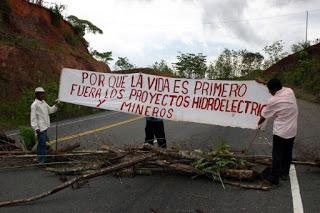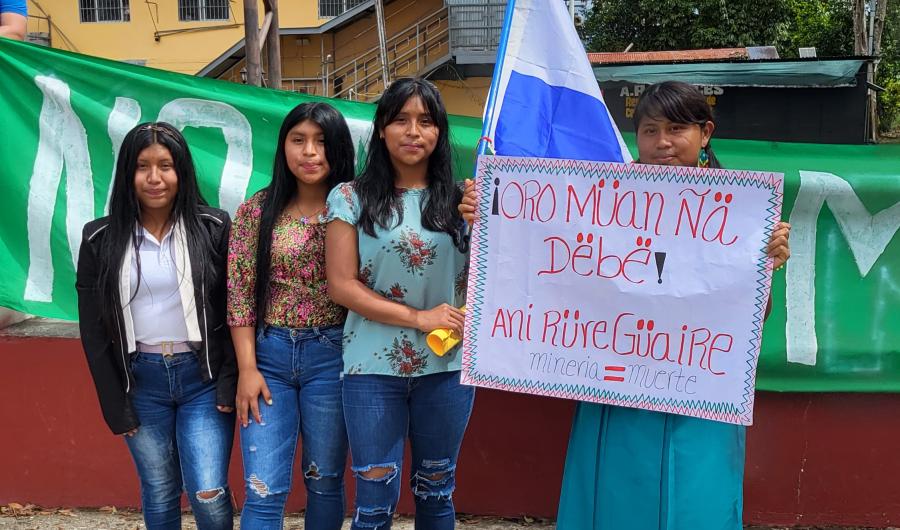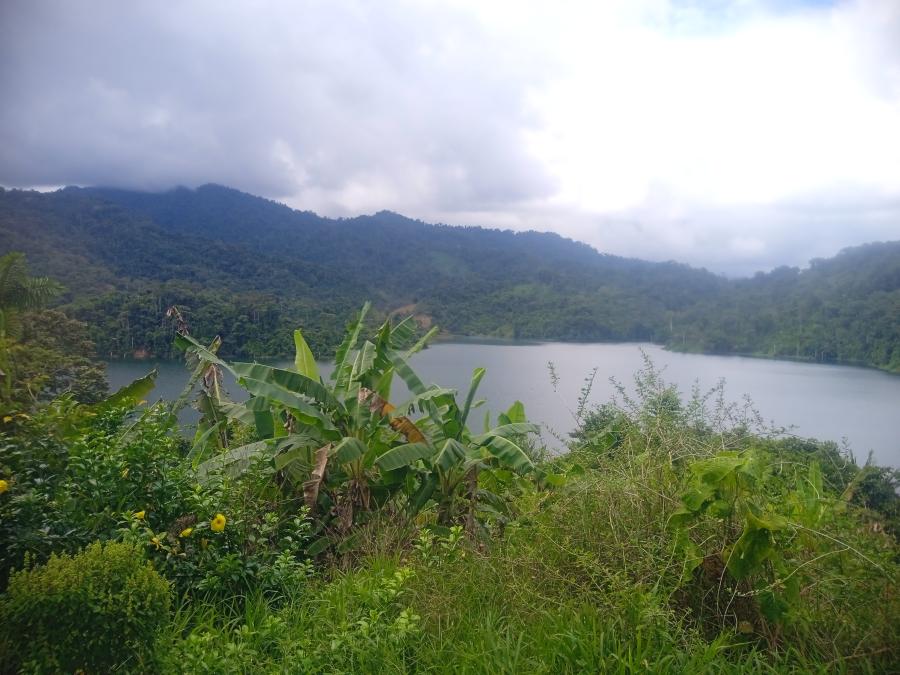
By Lawrence Reichard
Getting to the Indigenous hamlet of Kia in the Panamanian province of Chiriqui is no walk in the park. First you gotta get to the hot, steamy town of Tole, about six hours west by bus from Panama City. That’s the easy part. Then you ride for the better part of a half-hour in the bed of - or very precariously hanging off the back of - a pickup truck as it crashes over a “road” that would kill my Civic back home dead in a New York minute.
When I made the journey on the blistering afternoon of February 26, I counted 24 people in or hanging off the back of the truck. I didn’t think I was going to make it. The level and downhill parts weren’t too bad, but it was mostly uphill, and the uphills were straining my arms to the breaking point. I finally told my newfound friend and guide Manolo that I didn’t think I could hold out much longer, and he prevailed upon a man inside the truck bed to stand so I could squeeze one leg inside the truck bed. That helped.
From where the truck let us out Manolo and I walked, mostly in steep descent, for an hour to the Tabasara, Panama’s third-largest river. I walked with heavy heart, knowing I’d have to retrace every step, uphill, in the next day’s heat. You think you’re glad to hit the river; but think again. There is no bridge. We forded the river. The water reached up to my chest and the current threatened to carry me downstream—and this was the dry season. Manolo insisted on carrying my backpack—over his head. I didn’t argue.
Five minutes later we passed a two-inch plastic tube that carries a steady stream of clear drinking water from the Tabasara to the edge of the village, and then we were there. Kia, home to a small fraction of some 150,000 Indigenous Ngöbe people.
But soon you might not be able to get to Kia at all. There may be no Kia to get to. If the Panamanian government has its way, Kia and two more Ngöbe villages upriver on the Tabasara will be completely drowned by a hydroelectric dam being built to quench the relentless power needs of Panama’s explosive growth and its ever-growing demand for an air-conditioned lifestyle.
The Ngöbe people have inhabited the banks of the Tabasara for— in their words—forever, and if the Barro Blanco hydro project goes through, 460 of them will lose their homes, their villages, their livelihoods, their entire way of life, and what they call their paradise.
The Ngöbe say at least another 3,500 of their people will be “indirectly” affected, losing fishing grounds, subsistence farming and hunting lands, and good, clean, clear drinking water. Not to mention the complete underwater burial of petroglyphs the Ngöbe say are sacred and gifts from God.
Perhaps the most formidable structure in Kia is the relatively large one-room church. Service is held every Wednesday and Sunday night, well after dark. Everyone comes and it goes on for two hours. From the 12 by 12 “house” I was given to stay in, some 50 yards from the church, I was awoken by the service, which sounded like everyone in the village was talking at once—or perhaps some were talking and some were urgently, insistently humming. I wanted to enter the church and see what was going on inside, but I had no idea whether I was welcome, so I decided against it.
It’s hard to imagine the people of Ngöbe living anywhere else.
The Ngöbe grow rice, beans, yucca, bananas and coffee. They fish in the Tabasara, using hooks and single lines, and they hunt small deer, neques (large rodents), tigrillos (a wild 6-9 pound cat), rabbits, and armadillos. There are poisonous snakes in the forest, and sometimes villagers are bitten by them. But the Ngöbe have anti-venom, a concoction of local herbs they have harvested for this purpose, and this works for all but the worst of cases, which are taken to the hospital in San Felix, not far from Tole.
Manolo told me his people have locally-acquired herbal remedies for every ailment that afflicts them. He said the young sometimes leave the Ngöbe land and go off to Panama City in search of work. “They get into problems of addiction,“ he said. “Alcohol and drugs.” But many of them come back. “And they bring disease, HIV,” Manolo said. According to Manolo, there have been three cases of HIV. Two were successfully treated with local, wild herbs, and the third case was too far along for treatment. “We have treated them such that they are now leading normal, healthy lives,” Manolo told me.
In an environmental impact assessment (EIA) the Panamanian government said a total of five Ngöbe people would be affected the Barro Blanco project, and it offered compensation in the amount of $2,000 for every affected head of household. Not one member of the Ngöbe nation was consulted in the drafting of the government’s EIA.
When the Barro Blanco project was expanded beyond the parameters of the EIA, public outcry forced authorities to call a public meeting to discuss the project and its impact on local communities. But the meeting was held in a mestizo community unaffected by the project and the Ngöbe were not informed. When Ngöbe protesters showed up outside the meeting, only five of them were allowed to enter the meeting hall and they were not allowed to speak.
The government’s figure of five people affected by the dam is a mystery. In Kia alone I counted eight children and two adults. I was told that more of the village’s adults were camped out at a protest camp downriver - and according to a UN report, Kia is the smallest of three villages to be inundated by the Barro Blanco dam.
Kia’s population lives in six one-room houses in a small clearing surrounded by rainforest, and another 1-2 houses in another, nearby clearing. Some of the houses were made of machine-cut boards, and some were made of a locally grown bamboo-like plant. All had tin roofs, and they all contained hammocks for sleeping—no beds.
When Manolo and I arrived there were wandering around here and there chickens, pigs, dogs, a couple of horses, a lone cat, and the village’s children. Some kids were separating beans from their shells, others were washing dishes. In my two days in Kia I never heard a child cry or yell—I heard no one yell. La abuela (grandmother) was cooking rice and peas in a big cast iron pot on an open fire. No timer, no clock, no watch — it’s ready when it’s ready. “The beans are grown up there,” la abuela said, pointing to a mountain that rose steeply from the edge of the clearing. Gulp. For dinner la abuela served me coffee and a big bowl of the rice and peas, and in the morning she gave me coffee and a bowl of boiled yucca and plantains, which I shared with a dog, a chicken and the afore-mentioned cat.
Construction on Barro Blanco is already 50-60 percent complete, and it has already begun to displace about 150 mestizo campesinos who live downriver from Kia. According to Clementina Perez Jimenez, a Ngöbe leader, dam construction has already led to fish washing up dead on the banks of the Tabasara, something she says never happened before.
What has been built so far is clearly visible from the nearby Pan-American highway, and it’s impressive—it soars over the Tabasara riverbed. It’s hard to imagine the government and the capital behind the dam simply throwing up their arms and walking away from such a big project, especially with the power outages that plague Panama in the dry season, when the country’s heavy reliance on hydroelectric power literally shuts down the air-conditioning-dependent office towers and shopping malls that are sprouting up all over the place, fueled by Panama’s roaring economy.
The dam is being built by GENISA - Generadoras del Istmo (Generators of the Isthmus), a Honduran company linked to Luis Kafie, reportedly the wealthiest man in Honduras and a man accustomed to getting what he wants. And the project is being financed by the Dutch FMO Bank, the German DEG Bank, and the Central American Bank for Economic Integration, all quasi-public banks whose websites all trumpet their unshakeable, rock-solid commitment to social and environmental responsibility. And so it goes.
Panamanian law used to clearly and unambiguously prohibit the selling of any land within the Ngöbe-Bugle Comarca (reservation), which at 2,690 square miles is more than twice the size of Rhode Island. But much of Panama’s hydro capacity crosses reservation lands, and faced with a growing need for electricity and growing foreign, mostly Canadian, interest in mineral extraction on reservation land, the government came up with an ambitious plan to build 30 new hydroelectric dams, and a pliant national assembly dutifully loosened restrictions on the acquisition and use of reservation land.
Ngöbe resistance to Barro Blanco has been militant. Several times the Ngöbe have succeeded in completely shutting down the Panamerican highway, which, with only a short interruption in the Darien jungle of Panama and Colombia, stretches from Alaska to Chile and is the economic lifeline of Panama. But such protests have been met with force by Panamanian authorities, and so far three protesters have been killed. The government has issued several deadlines to leave the land that will be inundated by Barro Blanco, but the Ngöbe have dug in their heels, establishing a protest camp in the forest between Kia and the dam that is at times home to as many as 100 protesters.
The morning after my arrival in Kia, Manolo, two dogs and I set out for the protest camp, a half-hour downstream by foot, over some fairly precarious footing. “You have two choices,” Manolo said. “We can walk with more solid footing in the hot sun, or we can follow the river in the shade.” I chose the latter. Along the way we stopped, waded out into the middle of the river and clambered over a few big rocks piled up in the middle of the waterway. And there on top of the biggest rock was the faint image of one the Ngöbe’s petroglyphs.
The protest camp is a ragtag collection of tarps and pieces of cardboard laid out for sleeping on the forest floor beside the Tabasara. There’s a kitchen of sorts. Like the communal kitchen back in Kia, the camp kitchen is little more than a homemade table and a rudimentary fire pit. “The dam is right there,” Ngöbe leader Clementina Perez Jimenez says, pointing downstream. “It’s beyond that bend in the river.” As we talk, 10 or 12 other protesters are sitting and standing around talking and a half-dozen children are swimming and playing in the river, an idyllic scene. “Some of them we teach to swim, and to some of them it just comes naturally,” Clementina said.
With words that are echoed by Clementina and others, Manolo told me he and other protesters are going nowhere, come what may. “They can send the army, they can send the police, we don’t care. We are not going anywhere. We will fight to the death if it comes to that. We will die if necessary. Where are we supposed to go? There is nowhere to go. God gave us this land. It is sacred.” I heard this over and over in my two days in Kia.
In Kia there is a one-room, semi-enclosed school with nine wood desks - tables, really - and nine two-person benches behind them. Thrown in with all this rudimentary furniture is a full-size chair carved from a single piece of wood - I had never seen anything like it. The Ngöbe children divide their time between this Ngöbe school and a traditional Panamanian public school. They are taught Spanish and Ngöbe - both languages, both alphabets, both sets of numerals. I didn’t meet a single Ngöbe who wasn’t fluent in both languages.
Manolo told me the Ngöbe and their supporters in Holland and Germany are hoping to pressure FMO Bank, DEG Bank and the Central American Bank for Economic Integration to stop financing the project, but with the project at least half-way to completion, and given the demonstrated militancy of the Ngöbe and the Panamanian government’s demonstrated willingness to use violence, a peaceful resolution to the conflict is looking increasingly unlikely and the future of the Ngöbe looks troubled indeed.
Lawrence Reichard is an activist and freelance journalist currently residing in Panama. He can be reached at lreichard@gmail.com.



